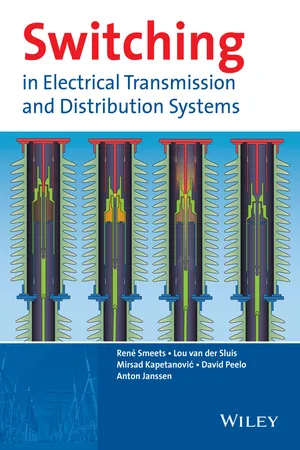
Switching in Electrical Transmission and Distribution Systems
- English
- ePUB (mobile friendly)
- Available on iOS & Android
Switching in Electrical Transmission and Distribution Systems
About This Book
Switching in Electrical Transmission and Distribution Systems presents the issues and technological solutions associated with switching in power systems, from medium to ultra-high voltage.
The book systematically discusses the electrical aspects of switching, details the way load and fault currents are interrupted, the impact of fault currents, and compares switching equipment in particular circuit-breakers. The authors also explain all examples of practical switching phenomena by examining real measurements from switching tests.
Other highlights include: up to date commentary on new developments in transmission and distribution technology such as ultra-high voltage systems, vacuum switchgear for high-voltage, generator circuit-breakers, distributed generation, DC-interruption, aspects of cable systems, disconnector switching, very fast transients, and circuit-breaker reliability studies.
Key features:
- Summarises the issues and technological solutions associated with the switching of currents in transmission and distribution systems.
- Introduces and explains recent developments such as vacuum switchgear for transmission systems, SF6 environmental consequences and alternatives, and circuit-breaker testing.
- Provides practical guidance on how to deal with unacceptable switching transients.
- Details the worldwide IEC (International Electrotechnical Commission) standards on switching equipment, illustrating current circuit-breaker applications.
- Features many figures and tables originating from full-power tests and established training courses, or from measurements in real networks.
- Focuses on practical and application issues relevant to practicing engineers.
- Essential reading for electrical engineers, utility engineers, power system application engineers, consultants and power systems asset managers, postgraduates and final year power system undergraduates.
Frequently asked questions
Information
1
Switching in Power Systems
1.1 Introduction
- Taking into or out of service some sections of the system, certain loads, or consumers. A typical example is the switching of shunt capacitor banks or shunt reactors, de-energization of overhead lines, transformers, and so on. In industrial systems, this type of switching is by far the most common of all the switching operations.
- Transferring the flow of energy from one circuit to another. Such operations occur when load current needs to be transferred without interruption from one busbar to another, for example, in a substation.
- Isolating certain network components because of maintenance or replacement.
- Isolating faulted sections of the network in order to avoid damage and/or system instability. The most well-known example of this is the interruption of a short-circuit current. Faults cannot be avoided, but adequate switching devices in combination with a protection system need to limit the consequences of faults.


1.2 Organization of this Book
Table of contents
- Cover
- Titlepage
- Copyright
- Dedication
- Preface
- 1 Switching in Power Systems
- 2 Faults in Power Systems
- 3 Fault-Current Breaking and Making
- 4 Load Switching
- 5 Calculation of Switching Transients
- 6 Current Interruption in Gaseous Media
- 7 Gas Circuit-Breakers
- 8 Current Interruption in Vacuum
- 9 Vacuum Circuit-Breakers
- 10 Special Switching Situations
- 11 Switching Overvoltages and Their Mitigation
- 12 Reliability Studies of Switchgear
- 13 Standards, Specification, and Commissioning
- 14 Testing
- List of Abbreviations
- Index
- End User License Agreement